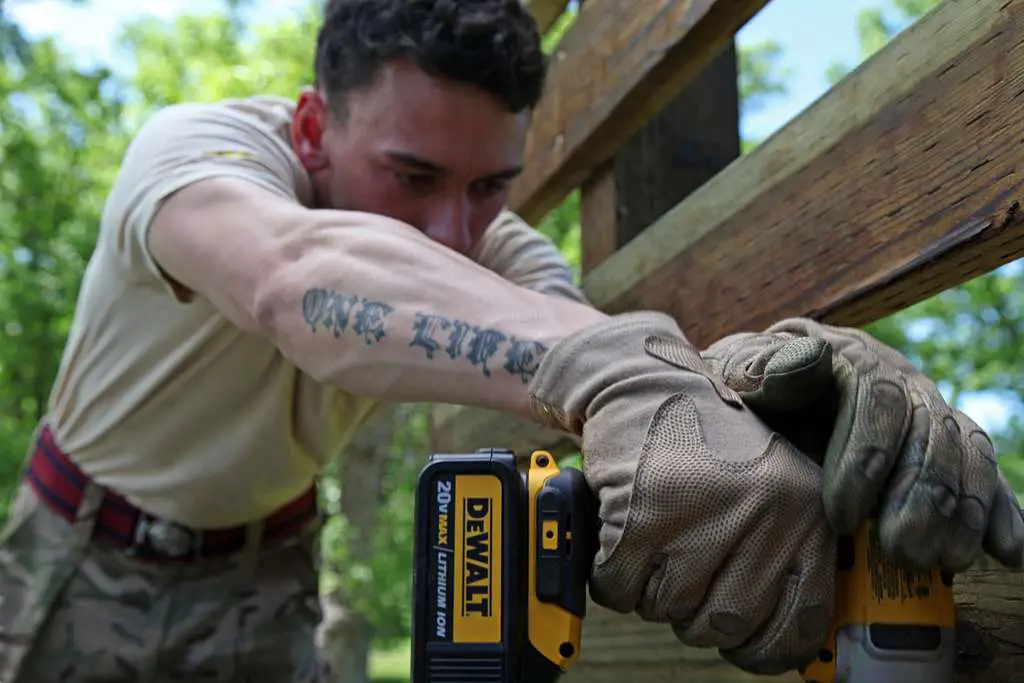How To Wear A Tool Belt

Tool belts are a great way to keep your tools and equipment organized and within easy reach when working. Wearing a tool belt correctly ensures that you have the right tools readily available when needed without having to move around too much. Knowing how to wear a tool belt properly can save you time and energy, as well as prevent any potential injuries. In this article, we’ll discuss how to wear a tool belt for maximum safety and efficiency.A tool belt is a belt worn around the waist that has pockets and loops to hold tools. It typically comes with a suspender system so that it can be worn securely and comfortably. Tool belts are most commonly used by professionals such as carpenters, electricians, and plumbers. They provide an organized way to store tools close at hand while working.
Belt Suspenders
Belt suspenders are a type of tool belt that is designed to provide support to the waist and prevent the belt from slipping down. They are typically made of strong, durable material and can be adjusted for a more comfortable fit. Belt suspenders usually feature adjustable straps and buckles that make it easy to adjust the fit for different body types and sizes. These types of tool belts are often used by professional tradesmen such as electricians, plumbers, carpenters, and other workers who need to carry heavy tools for long periods of time.
Leather Tool Belts
Leather tool belts are a classic choice for tradesmen who need to carry a variety of tools on their person. These belts are usually made from thick, durable leather that will hold up against wear and tear over time. Leather tool belts also come in a variety of sizes and styles, so you can choose one that fits your body type and size perfectly. Another benefit of leather tool belts is that they are often waterproof, making them an ideal choice for outdoor work.
Nylon Tool Belts
Nylon tool belts are a great option for those who need something lightweight yet still very durable. Nylon is a strong material that can stand up to the rigors of daily use in any environment. These types of tool belts usually feature several pockets or compartments that allow you to organize your tools easily and quickly. Nylon tool belts also come in a variety of colors so you can find one that matches your workwear or style.
Canvas Tool Belts
Canvas tool belts are another popular option for those who need something lightweight yet still very sturdy. Canvas is a lightweight material but is also very strong and durable when it comes to wear and tear. Canvas tool belts typically feature several pockets or compartments where you can store your tools securely while on the job. They come in various colors so you can find one that fits your style perfectly.
Durability
When choosing a tool belt, durability is an important factor to consider. A good tool belt should be made of strong, durable material that can withstand wear and tear. It should also have reinforced stitching and rivets for extra strength. The belt should be adjustable so that it can fit different sizes and shapes of users. It should also have a secure buckle and clasp to ensure that the belt remains in place while in use.
Comfort
When wearing a tool belt, comfort is key. The belt should have padding for extra comfort and support when carrying heavy items or tools. It should also have breathable fabric to help keep you cool while working. It’s important to make sure the tool belt fits properly so that it doesn’t cause discomfort or strain on your body while using it.
Storage Compartments
Storage compartments are essential for keeping all of your tools and supplies organized and easily accessible when needed. Look for a tool belt with multiple pockets and compartments of different sizes to store items like nails, screws, hammers, wrenches, pliers, tape measurers, etc. You may also want to look for a tool belt with additional features such as loops or straps to hold larger items such as power tools or ladders.
Price
Price is always an important factor when making any purchase, including a tool belt. You don’t want to skimp on quality but you don’t want to break the bank either. Look for one that has all of the features you need at an affordable price point that fits within your budget.
Overall, choosing the right tool belt can help make your job easier and more efficient by keeping your tools organized and easily accessible when needed. Consider these factors when selecting one – durability, comfort, storage compartments, and price – to ensure you get the best possible tool belt for your needs.
How To Wear A Padded Tool Belt
Wearing a padded tool belt can help you keep your tools organized and close to hand while you work. This type of belt is designed to provide extra comfort for those who are doing manual labor or other strenuous activities. Here are some tips on how to wear a padded tool belt correctly:
Firstly, make sure the belt fits properly. It should be snug but not too tight around your waist. If the belt is too loose, it will not stay in place and could cause discomfort.
Secondly, adjust the straps accordingly. The straps should be adjusted so that the belt is sitting comfortably around your waist. Make sure they are not too tight as this can cause discomfort as well.
Thirdly, it’s important to ensure that all the pockets and compartments are securely closed. This will help prevent tools from falling out while you are working, which could lead to injury or damage to property.
Finally, make sure that all tools are securely fastened onto the tool belt before starting work. This will prevent any accidents from occurring due to loose or unsecured tools. Additionally, it’s best practice to check that all pockets and compartments contain only the necessary tools for the task at hand.
By following these simple steps, you can ensure that you wear your padded tool belt correctly and safely while working. Not only will this keep you safe but it will also help keep your tools organized and easily accessible when needed.
How To Wear A Non-Padded Tool Belt
Wearing a non-padded tool belt is the best option for a comfortable and safe work experience. It allows you to have easy access to your tools while helping to reduce the risk of injury. Here are some tips on how to wear a non-padded tool belt for maximum comfort and safety:
The first step is to make sure that your tool belt fits properly. To do this, measure around your waist at the point where you would like the belt buckle to sit. Choose a belt that is 1-2 inches larger than your waist size, as this will ensure that you have enough room for movement and comfort.
Next, adjust the straps on the tool belt so that they fit snugly around your waist. Make sure that they are not too tight or too loose. If possible, try on different sizes until you find one that fits properly.
Once you have found the correct size, it’s time to put on your tool belt. To do this, position the buckle at your waist and then take hold of both ends of the strap. Pull them up firmly but not too tightly, and then fasten the buckle securely into place.
Finally, arrange all of your tools in their designated pockets so that they are easily accessible when needed. Make sure they are securely fastened in place before beginning any work tasks. With all of these steps complete, you should now be ready to go with your non-padded tool belt!

Tips For Wearing A Tool Belt Comfortably
Wearing a tool belt can be uncomfortable if not worn correctly. Here are some tips to help you wear your tool belt comfortably and get the job done right:
First, make sure to choose the right size of tool belt for your body type. A too-tight or too-loose belt can cause discomfort and hinder your ability to move around while working.
Second, adjust the straps of the tool belt so it fits snugly against your body without being overly tight or loose. You should be able to move freely without any discomfort.
Third, keep all of the tools that you need within easy reach. Avoid having to reach or stretch too far for a tool as this can cause strain on your back and shoulders.
Fourth, use an adjustable strap for hanging bulky items such as ladders or long tools so that they don’t pull on the waistband of the tool belt and cause strain on your lower back.
Finally, make sure to take frequent breaks when wearing a tool belt for prolonged periods of time. This will give you a chance to rest your body and prevent any excess strain from occurring.
Following these tips will help ensure that you wear your tool belt comfortably and get the job done efficiently without straining yourself!
How To Secure Your Tools In The Tool Belt
Securing your tools in the tool belt is an essential part of safety and organization. It can help protect yourself from injury, as well as keep your tools in the same place. The following steps will help you secure your tools in the tool belt:
1. Choose the right belt that fits securely around your waist. Make sure it has a thick, heavy-duty material with a sturdy buckle that will keep everything securely in place.
2. Choose a variety of pockets and compartments for different types of tools. This will make it easier to organize and access your tools quickly when needed.
3. Place heavier items on the bottom first, such as hammers and screwdrivers, followed by lighter items like pliers and wrenches. This will help keep the weight distributed evenly and prevent any items from moving around while you are working.
4. Use velcro or clips to secure small items like nails and screws in the pockets so they don’t fall out when you move around. This also helps to keep items organized and easily accessible.
5. Make sure to check all pockets periodically for any loose items that could fall out while you’re working or carrying your tool belt around.
By following these steps, you can ensure that your tools are safe and secure while still remaining organized in your tool belt. Not only will this help keep you safe, but it will also make it easier for you to find what you need when needed quickly and efficiently!
Best Practices When Working With A Tool Belt On
When working with a tool belt on, it is important to take certain safety precautions to ensure your safety and the safety of those around you. Here are some best practices to keep in mind when working with a tool belt on:
1. Always wear the proper protective gear, including safety glasses, gloves, and ear protection.
2. Make sure the tool belt fits properly so that it does not slip off or cause discomfort while you are working.
3. Familiarize yourself with the tools in your tool belt before beginning to work with them so that you know how to use them properly and safely.
4. Keep your tools organized and securely fastened in your tool belt at all times so that they do not become loose and cause injury or damage to yourself or others.
5. Inspect your tools regularly for any signs of wear and tear or damage, and replace any damaged tools immediately.
6. Make sure that all power cords are properly grounded before using power tools from your tool belt and unplug them when not in use for extra safety precautions.
7. Never leave your tools unattended when working with them to avoid accidents due to improper handling by someone else who may not be aware of the dangers associated with using certain tools improperly.

Conclusion
Wearing a tool belt correctly is essential to ensure safety and comfort while carrying out various tasks. It is important to choose a tool belt that fits properly and is designed for the task at hand. The number of pockets and the type of material used should also be taken into consideration when selecting a tool belt. It is also important to adjust the belt correctly and to wear it in the correct position to ensure maximum comfort. Lastly, it is vital to take proper care of the tool belt by cleaning it regularly and storing it appropriately when not in use.
With proper selection, adjustment, and care, wearing a tool belt can be a safe and comfortable way to carry tools around any work site.
